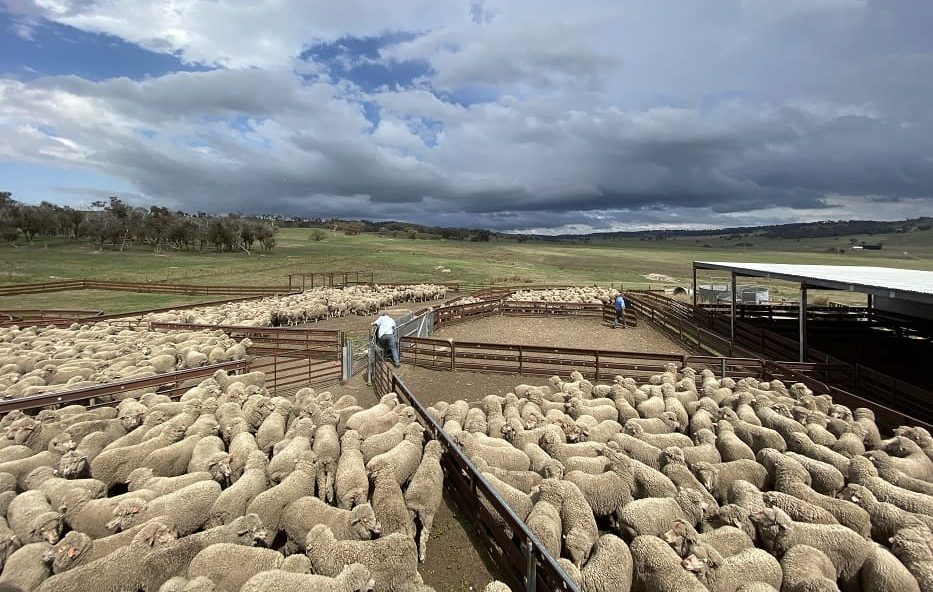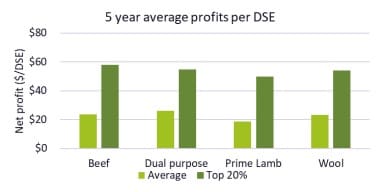
ANALYSIS of livestock operation benchmarking data indicates wool producers considering changing enterprises would be better served by quantifying and improving the production and financial performance in their existing business.
In an Australian Wool Innovation-commissioned study – ‘Why stay in wool sheep?’ – Agrista director John Francis concludes that improving what wool growers do can deliver more value than moving to an unfamiliar enterprise option.
His analysis of benchmarking data from 2019-19 to 2022-23 compared beef, dual purpose (Merino-terminal ram), prime lamb, wool (Merino-Merino). Analysis of the livestock enterprises with cropping was not in the terms of reference and there was insufficient benchmarking data on commercial shedding sheep lamb operations, Mr Francis said.

Figure 1 There is more to be gained by getting better at the existing enterprise than moving between enterprises.
Mr Francis concluded the variability within enterprise exceeds the variability between enterprises by an approximate magnitude of over four times in most enterprises.
“This suggests that, where the aim is to improve financial performance over the medium or long term, the primary focus should be on enhancing the results of the existing enterprise rather than moving between enterprises.”
In his key messages, Mr Francis said if the first response to the delivery of low profits or high workload in wool enterprises is to change enterprise, then think again.
“Wool enterprises have had less profit volatility than specialist meat enterprises and have delivered solid operating profits when compared to other breeding livestock enterprises over the last five years.
“When considering enterprise change there are a number of other considerations that generally aren’t paid adequate attention as their costs and benefits are difficult to quantify,” he said.
These include:
- Switching enterprises requires investment in understanding the profit drivers of a different enterprise and the development of new skills.
- Peak efficiency in a new enterprise is unlikely to occur instantly. There is usually a lag.
- The requirement for capital can be significant. Investment analysis shouldn’t just value the marginal benefits but also the up-front capital costs. Genetics, infrastructure and plant are usually the big ticket items.
Mr Francis concludes that there are large opportunities to improve wool flock profits even when wool prices are low, but they require a change to conventional thinking.
“Wool enterprise managers can start by measuring financial and production performance to identify the greatest rewards from the lowest cost.
“Examining the feed supply curve and aligning energy demands over the year is the next step,” he said.
“Simplifying operations within the system and examining infrastructure for opportunities to delivering higher levels of labour efficiency will also go a long way to improving enterprise profitability and satisfaction.”
Mr Francis said there appeared to be no data demonstrating why producers change from wool to alternative enterprises.
“It is plausible that the motivation for changing enterprise from wool to an alternative enterprise include the following perceptions.
- Higher profitability
- Lower labour requirements
- Easier workload
- Easier management
Mr Francis said many former wool growers have changed enterprise based on the perception that alternative enterprises would deliver higher profitability.
“This enterprise comparison data suggests that a change of enterprise is unlikely to deliver such a result and greater profits are more likely to be derived from improving performance within the existing enterprise than moving between them.
“This data also shows that specialist wool enterprises have delivered similar or superior profits when compared with alternative enterprises.
“Given the extreme cost of changing enterprise (skill development equating to foregone profits, infrastructure investment and genetic investment) a starting point for wool producers considering changing enterprise should be to quantify the level of production and financial performance in their existing enterprise,” he said.
“This approach allows for the objective assessment of enterprise performance and identifies low cost opportunities to improve productivity and profitability within the enterprise before considering moves between enterprise.”
The full report can be accessed via Why stay in wool sheep?

Dear John and AWI, wool producers should be better served by the goddam useless bureaucrats in AWI with no marketing. There is no benchmarking for their actions … that’s because there aren’t any.
Take a cheap shot like that at our wool producers and you’ll be out of a job.
I’ll be voting zero for AWI (in WoolPoll) after reading your this.
Brendan
I will be voting zero (in the WoolPoll) as well.